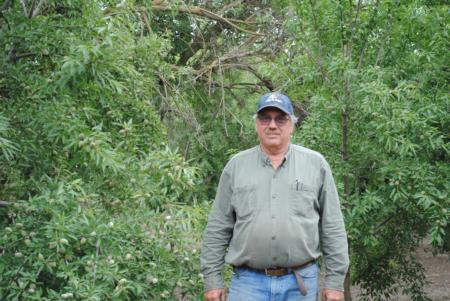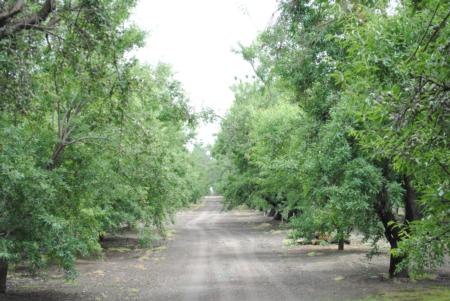Tom and Dan Rogers' Almond Orchard
Tom Rogers and his brother Dan are almond growers in Madera, California. They farm 175 acres on a ranch that has been in the family for three generations. In 1916, their grandparents purchased the property as a dairy and dry-land farming operation. It was not until the early 1980s that Tom’s father planted the first block of almonds. They currently grow Nonpareil Carmel and Butte, and Padre and Nonpareil Monterey almond varieties.

The farming philosophy of the orchard is simple: take care of the soils and they will take care of the trees. To that end, Tom and Dan collect various data and monitor their soils and plant nutrient status to inform their irrigation and nutrient management programs. They believe strongly in protecting their natural resources and supporting the environment to produce healthy trees and quality almonds.
Tom is a Board Member of the local Farm Bureau and was the recipient of the 2014 Farm Water Stewards Award.
Nutrient Management Practices
Since 2008, Tom and Dan have been working with two companies to develop and monitor their fertility plan. These companies take and analyze soil and leaf samples. One soil sample per soil type is taken to determine available nutrients across the farm. NRCS maps indicate varying combinations of sandy-loam and hardpan clay soils. Leaf samples are used to monitor the nutrient status of the trees throughout the season. Samples are taken once a month from the same tree branch to allow them to anticipate any nutrient deficiencies and adjust the program throughout the season.
In February of each year, they develop the fertility plan for the season, receiving recommendations for the timing and rate of fertilizer applications from California Ag Solutions. Fertilizers are generally applied from mid-March to June, unless leaf samples indicate a need for additional applications. Compost is then applied post-harvest in December. Harvest data is also used to guide the nutrient management plan.
Nitrogen, potassium, calcium, and microbial stimulants are all included in their fertility plan and applied with foliar sprays or fertigation. They may add boron as needed.
An Evolving Nutrient Management Plan
“The worst time we were burned,” Dan says, “Is when we did the same thing year after year.”
Tom and Dan are committed to changing and adapting their program with each growing season and to trying new things. When their father first started the orchard, nitrogen was applied once, post harvest. Later, this was increased to three applications over the season, and in the early 2000s, they were using foliar sprays 12 to 14 times in the season. But with all of these programs, they saw limitations: soil health decreased, yields plateaued, and in some blocks, the lower branches on the almond trees stopped growing entirely.

Since 2006, Tom and Dan have been working with new companies to fine tune the timing of the application of their fertilizers, the rate of application, and the micronutrients they apply. They have reduced foliar sprays down to 6 or 7 a season and have diversified the micronutrients they apply.
Tom is quick to say that he is always learning on the farm; the changes that they made to their nutrient management plan and the benefits they have seen on-farm are incremental and on-going. But, as they have adopted application rates, timing, and micronutrient solutions, they have seen many benefits emerge:
- An increase in nut size. Their average yields are 3,000 lbs per acre
- An increase in nut quality and increased nutritional content in the almonds
- An increase in soil health, more microbes, increased water infiltration rate, and increased worm activity
- Regrowth of the low branches on stressed blocks
- Decreased application frequency means decreased labor and associated costs
- Decreased nutrient leaching with more frequent and target applications
Almond Orchard Management
Since the 1990s, the orchard has been no-till. They stopped tilling because they were concerned about cutting up the productive tree roots in the top four to six inches of soil. Since they have stopped tilling, they have not had any problems with soil compaction.
In adult trees, they will prune dead limbs. Trees are spaced at 22 by 22 feet or 20 by 20 feet. The larger spacing is better for harvesting equipment.
Irrigation events are scheduled with aerometers and on-site weather stations. They also track tree evapotranspiration. This allows for precision irrigation scheduling that optimizes water use and ensures that nutrient rich water is not leached beyond the root zone into the groundwater. The older blocks of almonds are watered with micro-sprinklers, and new blocks have drip-irrigation lines. They are planning on replanting the older blocks and installing double drip-irrigation.
Costs
Tom indicates that he spends $700 acre on foliar sprays and ground fertilizers each year. The results of the fertilizers in terms of crop yield and quality justify this cost for their farm. Tom suggests that this cost must be managed on a farm-by-farm basis, and that growers should weigh the cost of their fertilizers against their yields to determine what is affordable for them.
Fertilizer applications at a glance
- Nitrogen
- Compost
- Foliar Sprays
- Fertigation
- Irrigation Water
- Potassium
- Foliar Sprays
- Fertigation
- Calcium
- Gypsum Fertigated
- Boron
- Foliar spray at bloom if needed
- Water penetrant
- Microbial Stimulants
Nitrogen Budget
Their nitrogen budget accounts for compost, nitrates in the irrigation water, and applied nitrogen via foliar sprays or fertigation. Although the exact amount will vary each year depending on need, generally, Tom applies 200-250 units of nitrogen per acre. He first determines the units of nitrogen applied via compost and irrigation water, and then applies around 100-120 units of nitrogen via foliar sprays or fertigation. (Table 1)
Table 1: Average units of N applied per acre for entire growing season
| Compost | 3 to 4 tons/acre |
| Nitrates from irrigation water | 90-100 lbs/acre* |
| Applied Nitrogen | 100-120lbs/acre |
| Total Nitrogen | 200-250 lbs/acre |
*If 4 acre feet of water are applied a season
Foliar Spray Frequency
Although this may change from year to year, generally they use foliar sprays from March through June at the following growth stages:
- Pink Bud
- Bloom
- Full Bloom
- Petal Fall
- Full Leaf
- Nut Fill
They may also spray after harvest if that year had an especially large crop load.
Calcium amendments
Liqua-Gyp is applied to increase the infiltration rate of the irrigation water. Tom indicates that getting the irrigation water down into the soil profile has always been a challenge on the farm, but is necessary to reach the deep roots and to reduce standing water in the orchard.
Last year, in 2013, Liqua-Gyp was applied once in the spring and once in the fall, and they saw an increase in the water infiltration rate. This year, they are applying the same amount of Liqua-Gyp, but will be increasing the application frequency, by applying the gypsum with every other irrigation. They are interested to see if this further increases water infiltration rates.
Advice for Other Growers
- Never use the same practices year after year, always monitor and collect information, adjust your program, and learn from your farm.
- Do not farm alone! Seek advise from your crop advisors, companies, UC Extension, and your neighbors.
- Tom and Dan both stress protecting the environment and natural resources: “I live here,” Dan says, “We have to take care of the environment to help the trees grow the best crop they can.”
